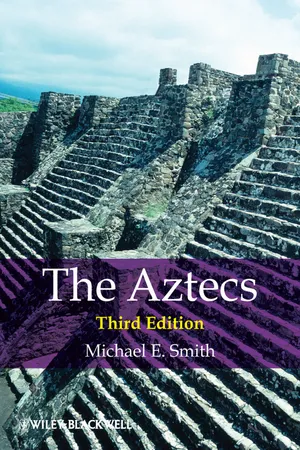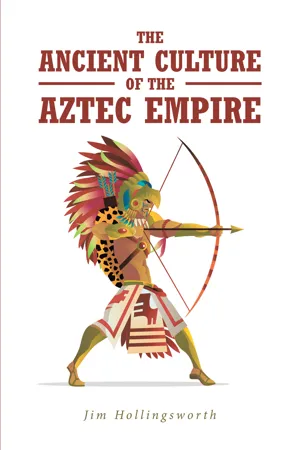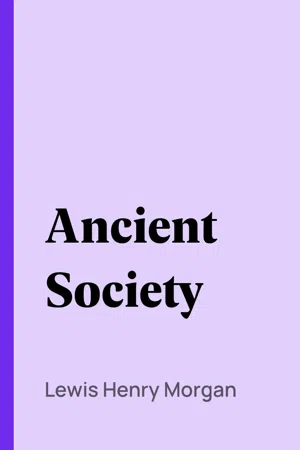Aztecs
The Aztecs were a Mesoamerican civilization that flourished in central Mexico from the 14th to the 16th century. They were known for their advanced agricultural practices, intricate social structure, and impressive architectural achievements, including the construction of the city of Tenochtitlan. The Aztecs also had a complex religious system and are often associated with human sacrifice.
6 Key excerpts on "Aztecs"
- Ross Hassig(Author)
- 2016(Publication Date)
- University of New Mexico Press(Publisher)
...There, they also acquired their patron god, Huitzilopochtli, whom they thereafter carried on their migrations until they entered the Valley of Mexico toward the end of the twelfth century, before they eventually settled permanently in Tenochtitlan in 2 Calli (AD 1325). Until they reached the southern Valley of Mexico, where they interacted with more sophisticated urban peoples, and perhaps even until they established Tenochtitlan, the history of the Aztecs is sparse, focused primarily on recording the years of wandering interspersed by years of settlement in a manner they could not have known at the time, and is somewhat speculative. Furthermore, after they became an empire Aztec history was apparently altered to conform to their views of themselves and their historical past. The Aztecs adapted to many Mesoamerican customs and practices during their southward migrations, but when they settled in Tenochtitlan, they were still a minor group of relative barbarians amid the sophisticated urban cultures of central Mexico. Yet by 1372, with growing prosperity and sophistication borrowed from their neighbors, they became a kingdom, embarking on 150 years of royal rule, 56 as a kingdom followed by 93 as an empire. When the Aztecs became an empire in 1428 after the overthrow of their erstwhile masters, the Tepanecs, Aztec society underwent a number of major changes, especially among the nobility. As with state societies generally, class now arguably determined one’s place in society more than kinship. 5 With the Aztec rise, Tenochtitlan emerged as the dominant city of central Mexico, and by the time of the Conquest, its population had vastly outstripped that of any other city, not only in the Valley of Mexico but elsewhere in the New World and in Europe. Its burgeoning population changed the valley socially, politically, and economically, reorienting the primary flow of tribute from the former Tepanec capital of Azcapotzalco to Tenochtitlan...
- eBook - ePub
- Jorge Enrique Hardoy(Author)
- 2014(Publication Date)
- Routledge(Publisher)
...Last but not least was the need for slaves to be sacrificed to the gods as state and religion merged into one unified system. In the last years of their brief history, the Aztec nation included more than 300 vassal tribes which never amalgamated into a political or administrative entity. The language spoken by the Aztecs and their near neighbors was Nahuatl, but the Otomí, Huaxtecs, Totonacs, Mixtecs, Zapotecs, and Matlaltecs, to name only a few of the partially or totally subjugated groups, conserved their own languages, cultures, and gods. Even within the relatively loose limits of the Aztec state, a number of peoples maintained a precarious independence: the Tlaxcaltecs in the very heart of the empire whose capital was only a few hours march from Cholula; the domain of Meztitlan, northwest of the Valley of Mexico; 4 the Yopi on the Pacific Coast, and the Chinantecs 5 from the mountainous region north of Oaxaca (Soustelle, 1956). The Aztecs were only one of a number of semi-nomadic groups that invaded Mexico's central plateau after the twelfth century, provoking the disintegration of the Toltec empire and the fall of Tula. At the beginning of the thirteenth century, guided by their god Huitzilopochtli, the Aztecs established themselves in the area around Tula. They did nothing without consulting Huitzilopochtli, who told them where to settle, how to plant seeds and harvest the crops, and later advised the scouts as to which directions they should take in search of new lands where the people could prepare the next stage in their slow peregrination. In 1215 the Aztecs arrived in the center of the Valley of Mexico. The thirteenth century passed as they avoided encounters with those peoples already established in the Valley who were stronger than themselves...
- eBook - ePub
- Michael E. Smith(Author)
- 2013(Publication Date)
- Wiley-Blackwell(Publisher)
...Chapter one The Aztecs of Mesoamerica Next morning, we came to a broad causeway and continued our march towards Iztapalapa. And when we saw all those cities and villages built in the water, and other great towns on dry land, and that straight and level causeway leading to Mexico, we were astounded. These great towns and cues [temple-pyramids] and buildings rising from the water, all made of stone, seemed like an enchanted vision from the tale of Amadis. Indeed, some of our soldiers asked whether it was not all a dream. It is not surprising therefore that I should write in this vein. It was all so wonderful that I do not know how to describe this first glimpse of things never heard of, seen or dreamed of before. Bernal Díaz del Castillo, The Conquest of New Spain With these words Bernal Díaz del Castillo, a soldier in Hernando Cortés's conquering army, expressed his amazement at the Aztec capital city. When the Spaniards approached Tenochtitlan in 1519, it was one of the most populous cities in the world, the largest ever to flourish in the pre-Hispanic New World, and far richer and more grandiose than any community the Spanish soldiers had ever beheld in their home country (figure 1.1). Expecting to find a simple, backward people, the conquerors were awed by the civilized nature of Aztec society. The kings and royal courts, the huge bustling marketplaces with their orderly layouts, the wealth of the nobility, the detailed scientific and technical knowledge of the priests and artisans, these and many other features of Aztec civilization filled the conquerors with awe. Figure 1.1 Artist's reconstruction of the Templo Mayor and the sacred precinct in the heart of Tenochtitlan (modified after Marquina 1951:lamina 55) Much about the Aztecs continues to amaze us today. When workmen in Mexico City accidentally uncovered a huge Aztec sculpture in 1978, the Mexican government quickly mounted one of the largest excavations in the country's history...
- eBook - ePub
A History of Architecture in all Countries, Volumes 1 and 2, 3rd ed.
From the Earliest Times to the Present Day
- James Fergusson, Richard Phené Spiers, (Authors)
- 2017(Publication Date)
- Perlego(Publisher)
...The Mexicans do not pretend to any very remote antiquity or divine descent. There are no heroes who live thousands or tens of thousands of years; nor any of the other extravagances that usually mark the dawn of history in the Old World. On the contrary, the Mexican annals modestly commence with the arrival of the Toltecs in Anahuac in the 5th or 6th century, and with the beneficent teaching of a stranger, Quetzalcoatl, who lived among them, taught them architecture and the agricultural arts, instructed them in their religious duties, and then, like Lycurgus fifteen centuries earlier, left them by sea, promising to return. For 300 or 400 years from this time the Toltecs lived in peace and prosperity, covering the table-land, it is said, with their monuments. But evil times came; famine, internecine wars, and disasters—interpreted as evidences of the wrath of the gods—drove them from their homes, and they migrated, it is said, southwards to Yucatan; where it is usually assumed that they erected the architectural monuments we now find in that country. Central America is, however, one of the most fertile countries in the world, and capable of supporting—indeed did support—an immense population with very little labour; so it seems probable that it was inhabited long before the time mentioned. [491] This, however, by no means militates against the idea that the Toltecs may have been the first to communicate to their new country many of the arts they had elaborated in Anahuac. Indeed, it is to such a combination of two not very dissimilar races that all the greatest results in art or civilization have been attained in other parts of the world, and it may have been the case here also. Politically the annals of Anahuac are a blank between the departure of the Toltecs and the arrival of the Aztecs in the middle of the 12th century...
- eBook - ePub
- Jim Hollingsworth(Author)
- 2021(Publication Date)
- Covenant Books, Inc.(Publisher)
...Though masked by a desire to reach the heathen for Christianity, in the end it seems that the result was more temporal than religious. The Aztecs built a fabulous civilization, one of which they could be proud. Yet their religious system was completely decadent, and for this they no doubt fell. First was the very moral implication of the sacrifice of human beings, often brothers in the flesh, and many times accompanied with cannibal practices. But even more, their religion had prepared them for the return of their god, Quetzalcoatl, the arrival of a white man from the east who would come to rule over them. To the extent they believed this prediction they were in the power of the Conquerors. Without this belief Cortéz with his little band could never have overcome armies many thousand times greater than his own. Whatever may be thought of the Conquest in a moral view, regarded as a military achievement it must fill us with astonishment. Cortéz and a handful of adventurers, indifferently armed and equipped, landed on the shores of a powerful empire inhabited by a fierce and warlike race, and in defiance of the reiterated prohibitions of its sovereign, forced their way into the interior. This they did without knowledge of the language or of the land, without chart or compass to guide them, without any idea of the difficulties they were to encounter, totally uncertain whether the next step might bring them on a hostile nation, or on a desert, feeling their way along in the dark, as it were. They were nearly overwhelmed by their first encounter with the inhabitants, yet under the general’s dauntless leadership they pressed on to the capital of the empire, and having reached it, threw themselves unhesitatingly into the midst of their enemies. It defies belief that, so far from being discouraged by the extraordinary spectacle exhibited there of power and civilization, they should have been but the more confirmed in their original design...
- eBook - ePub
Ancient Society
Or, Researches in the Lines of Human Progress from Savagery, through Barbarism to Civilization
- Lewis Henry Morgan(Author)
- 2014(Publication Date)
- Perlego(Publisher)
...The government they formed was a confederacy of tribes, and nothing more; and probably not equal in plan and symmetry with that of the Iroquois. In dealing with this organization, War-chief, Sachem, and Chief will be sufficient to distinguish their official persons. The pueblo of Mexico was the largest in America. Romantically situated in the midst of an artificial lake, its large joint-tenement houses plastered over with gypsum, which made them a brilliant white, and approached by causeways, it presented to the Spaniards, in the distance, a striking and enchanting spectacle. It was a revelation of an ancient society lying two ethnical periods back of European society, and eminently calculated, from its orderly plan of life, to awaken curiosity and inspire enthusiasm. A certain amount of extravagance of opinion was unavoidable. A few particulars have been named tending to show the extent of Aztec advancement to which some others may now be added. Ornamental gardens were found, magazines of weapons and of military costumes, improved apparel, manufactured fabrics of cotton of superior workmanship, improved implements and utensils, and an increased variety of food; picture-writing, used chiefly to indicate the tribute in kind each subjugated village was to pay; a calendar for measuring time, and open markets for the barter of commodities. Administrative offices had been created to meet the demands of a growing municipal life; a priesthood, with a temple worship and a ritual including human sacrifices, had been established. The office of head war-chief had also risen into increased importance. These, and other circumstances of their condition, not necessary to be detailed, imply a corresponding development of their institutions...





